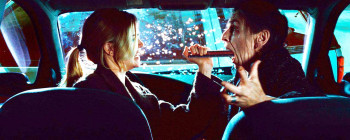 Sam Raimi’s Drag Me to Hell exists mostly to remind the world that Sam Raimi made The Evil Dead and can still make The Evil Dead, which is good to know because Sam Raimi is re-making The Evil Dead.
Sam Raimi’s Drag Me to Hell exists mostly to remind the world that Sam Raimi made The Evil Dead and can still make The Evil Dead, which is good to know because Sam Raimi is re-making The Evil Dead.
But amid all the giggle-inducing grossness are a few grace notes – unnecessarily skillful business that reminds us that Raimi also made A Simple Plan. I’m going to talk about one of those bits.
Late in the movie, the protagonist needs to give away a button to rid herself of a gypsy curse. She and her beau are in his car, and he slams on the brakes. The envelope holding the button gets mixed up with his stuff, she retrieves an envelope, and the audience thinks: She obviously grabbed the wrong one.
 But when she’s trying to deliver said envelope, I noticed that a round outline was visible on it. And I thought: I guess I was wrong.
But when she’s trying to deliver said envelope, I noticed that a round outline was visible on it. And I thought: I guess I was wrong.
This is an example of how good storytelling isn’t just about being economical; one should also be a magician.
For the most part, a well-told tale is one in which every element is essential. The problem this creates for many screenwriters and directors is that when they’ve got themselves a tight narrative, economy often works against it; astute audiences are going to figure things out before they’re supposed to. In a mystery in which one character seems to be superfluous, for example, that person is easily identifiable as the murderer. An apparently random object featured in a shot in a fight scene will inevitably be a critical weapon.
The emphasis placed on the envelope getting lost among the boyfriend’s stuff, then, is a tell, a giveaway.
But Raimi then undercuts that, and in so doing knocks viewers off-balance. He doesn’t just create doubt about the wrong-envelope conclusion; he gives the audience certainty that she has the right one. We see that the button is in the envelope.
Good illusionists do the same thing. Their deceptions are predicated on the flawed beliefs they engender: They convince us that we’re seeing things that we’re not actually seeing.
We have not seen the button in that envelope; we’ve seen an envelope with something circular in it about the size of a button. What we’ve forgotten by this point – with all the fluids and bugs and the anvil – is that the geeky boyfriend is a coin collector.
So when, at that train station, he produces the button that he found in his car and inquires about that envelope with the coin in it, it’s a wicked – and fairly earned – surprise. And then his girlfriend gets dragged to Hell.
Ummm … was that a spoiler?


Actually,such a big deal was made about the coin, we were certain that it was NOT the button that was returned to the old woman. The only surprise was when the resolution would happen, not what the resolution would be.
Monkeyboy: Perhaps for you, but not for me. In retrospect, it’s obvious what Raimi was up to, but I had seriously lost sight of the coin.
Some people are more in-tune with these things than I am. You might be one of those people.